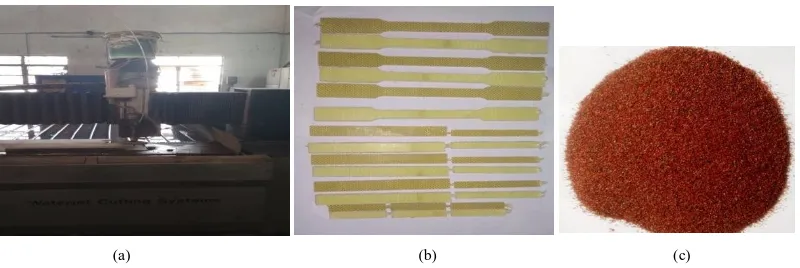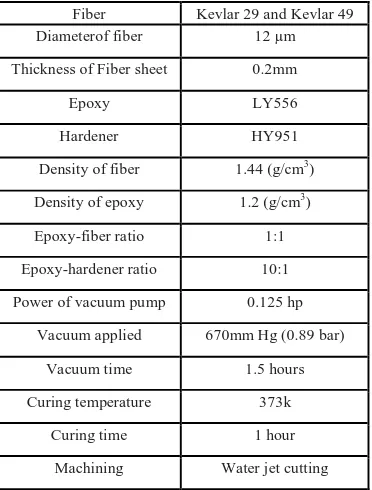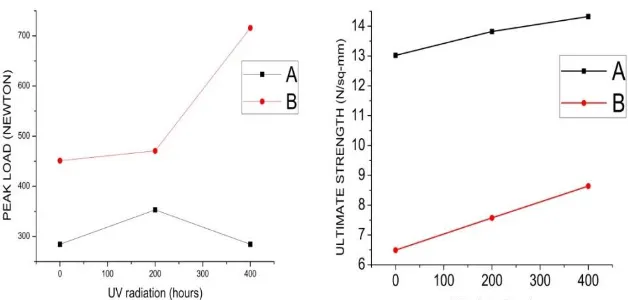Aromatic Polyamide Fiber Reinforced
Polymer Composite Material Fabrication and
Testing
Deepak Gaur1, Om Prakash2
Senior Research Assistant, DRDO Bhavan, DRDO, New Delhi, India1
Deputy Director, BF&A, DRDO Bhavan, DRDO, New Delhi, India2
ABSTRACT: In the modern era, application of composites polymer materials has grown widely in the aeronautical and aerospace domain. Sheer domination of composite materials can be seen in the industry nowadays. The structural strength of the composite material depends on the characteristics of the matrix phases and the reinforcements. Further inclusion of hardening material particles into the structural matrix improves the overall characteristics and properties of the composite polymer material. In the current research, fabrication of the Aromatic polyamide (Aramid) fiber reinforced polymer (AFRP) composite material was carried out using epoxy resin hardening material particles in the matrix form using techniques like Vacuum assisted resin transfer molding (VARTM) and Hand lay-up process. For the base matrix, epoxy resin was used. For observing the change in the properties, newly formed composite material specimens were then tested by exposing them to mechanical and structural tests such as compression, tensile and flexural. Practical evaluation of the improvement in the mechanical properties of the newly formed composite material was carried out.
KEYWORDS: Composite, Hardener, Aramids, Vacuum assisted resin transfer molding, Hand lay-up process, Compression, Tensile, Flexural.
I. INTRODUCTION
In Aeronautical and Aerospace domain structural weight is one of the most important factor considered. Designers and Engineers have worked diligently over a period of time for enhancing the lift to weight ratios. Composite materialshave played a vital role in the reduction of weight. Composite materials are very versatile when it comes to applications. They are used in transport or automotive, construction, civil infrastructure, recreational and sports equipment, ducts, tanks, hoods, marine, electrical, healthcare industry. Most of the used conventional materials are limited when it comes to achieving an optimal unison of mechanical and structuralproperties such as toughness, stiffness, strength, and density. In order to overcome these limitations of the present-day requirement in the modern era technology, composite materials are most likely preferred materials in current era. Composite materials have superior physical and mechanical properties in comparison to majority of the abundantly available conventional materials. Composite materials have properties like low weight, high strength, and corrosion resistance. They are very good electrical and thermal insulators. Also, they possess properties like resistance to UV radiations, chemicals, and salt water. Ingenious ideas and designs which were quite impossible earlier have been achieved without any compromise in strength or performance.
Paper is organized as follows. Section II describes the material selection based on the structural and mechanical properties. After selection of material, fabrication process was carried out and desired specimens were produced which is presented in Section III. In Section IV, testing methodology for determining the structural and mechanical properties is presented. Section V presents experimental results showing results of specimens tested. Finally, Section VI presents conclusion.
II. MATERIALSELECTION
A. Aromatic Polyamide (Aramid) Fiber
Aramid fiber is a strong, heat resistant synthetic polymer which is quite abundantly used in aerospace industry for both military and civil applications such as substitute to asbestos, bulletproof body armor, and bicycle tires. In such fibers, hydrogen bond is present within the fiber molecules that helps in efficient transfer of mechanical stress, thus allowing it to use relatively low weight molecular chains. Nomex and Kevlar are the two trademark names of the aramid fibers. Nomex is meta-aromatic polyamide (meta-aramid) and Kevlar is para-aromatic polyamide (poly-aramid).
A.1. Kevlar Fiber
In aromatic polyamide group, Kevlar is an organic fiber. Distinctive chemical composition and unique characteristics of aromatic polyamide family distinguishes them especially Kevlar fiber from other manmade commercial fibers. Kevlar fiber has a unique combination of high modulus of elasticity, high strength, toughness, and thermal stability. It was developed for advanced technology and demanding industrial applications. To comply with the broad range of end users demand and applications multiple variants of Kevlar fiber polymers are produced. Molecular structure of Kevlar fiber possesses nearly ideal crystalline packing and extended molecular chain configuration. In terms of structural strength, it is 5 times stronger than steel. This is due to the presence of the benzene ring in the Kevlar molecular configuration. Although, it is chemically stable under a wide variety of ambience exposure scenarios, certain strong aqueous bases, acids and sodium hypochlorite can cause degradation in structural, physical, and chemical properties. Tenacity reduces with increasing alkalinity. At relatively high temperatures, Kevlar materials tend to decompose. Temperature at which Kevlar decomposes varies with the rate of the length of exposure and the temperature rise. Also, at relatively high humidity, Kevlar fiber absorbs moisture at faster rate in the initial phases, eventually leading to higher final equilibrium level.
In substantial use of Kevlar fiber material properties, a lot of development has been carried out. Whilst it is predominantly used in numerous fields, its substandard compressibility characteristics still requires further research.
III.MATERIALFABRICATION
Methodology involved in fabrication of Kevlar material specimens is as follows.
1. The specimen fabrication was carried out using Vacuum assisted resin transfer molding and Hand lay-up process.
2. Diamond scissor was used to cut Kevlar fiber into 16 layers.
3. Along with the hardener (HY951), epoxy resin (LY556) was used as the base matrix.
4. Fabrication of half of the test specimens was carried out through continuous fiber reinforcement and rest of the test specimens were fabricated using chopped and continuous fiber reinforcement combination in the alternate layers.
5. Waterjet cutting is used to cut specimens according to the specified ASTM standards in ASTM D4762 standard guide.
6. The waterjet cutting of the specimens with the garnet sand as an abrasive was carried out at 3000 bar.
Fig. 2.Material Fabrication (a) Vacuum assisted resin transfer molding (b) Fabricated material
Fig. 3.Material Fabrication (a) Waterjet cutting (b) Cut test specimens (c) Garnet sand (abrasive) (a) (b)
Table 1: Datasheet.
Fiber Kevlar 29 and Kevlar 49
Diameterof fiber 12 µm
Thickness of Fiber sheet 0.2mm
Epoxy LY556
Hardener HY951
Density of fiber 1.44 (g/cm3)
Density of epoxy 1.2 (g/cm3)
Epoxy-fiber ratio 1:1
Epoxy-hardener ratio 10:1
Power of vacuum pump 0.125 hp
Vacuum applied 670mm Hg (0.89 bar)
Vacuum time 1.5 hours
Curing temperature 373k
Curing time 1 hour
Machining Water jet cutting
Table 2:Specimen fabrication details.
IV.TESTING
A. Ultra Violet Testing
Aromatic polyamide materials are extremely sensitive to UV exposure. Excessive exposure to UV radiations can cause chain breaking and depolymerization which will eventually result in decrease in fibres ultimate compressive strength. Fiber samples are artificially damaged through continuous and prolonged exposure to UV radiation. In comparison to intermittent exposure, continuous and prolonged exposure causes extensive damage as it depends on degree and extent of exposure. So, it is important to protect such polymers that possess UV absorption groups, from the sunlight deleterious effects. Accelerated exposure testing is used to analyse the damages caused over a prolonged and continuous exposure of such polymer materials to UV radiations.
Meteorology laboratory was used to conduct this experiment. A support mounted UV lamp was used to direct most of the UV radiation to the fiber sample for avoiding excess increase in temperature, natural ventilation was ensured during the test phase through an opening underneath the cylinder. The UV lamp relevant feature in terms of the emission spectrum is the dazzling line approximately 300nm (within the UV spectrum) due to the reason that it tends to fall exactly on resonance with the aramid fibers unstable N-H bond critical wavelength.
Sheet thickness 0.2mm
Sheet weight 18 gm
Number of sheets drawn 16
The aramid fiber specimens were continuously exposed to UV radiations for 400 hours in order to evaluate the damage tolerance of the specimens.
Fig. 4.UV Testing (a) Osram vitalux light bulb technical details for scale comparison (b) Experimental setup for guiding light flux onto the fiber specimens
B. Tensometer Testing
Tensometer device is used for conducting tests and obtaining results. This device aids in measurement of material mechanical properties such as tensile strength and Elastic Modulus (i.e. degree or extent to which material can be stretched under stress). Tensometer is basically a Universally Testing Machine (UTM) within which two grips are used for loading the material sample. Machine operates either by driving screw assembly or by a hydraulic ram. An apparatus is used for gripping the sample material at both ends, which applies tensile load or stretches the sample slowly in lengthwise direction until it fractures. For analysis, load or pulling force is plotted against displacement or change in material length. Stress-strain curve is obtained by converting load into stress value and displacement into strain value.
PC2000 tensometer, which is a mini horizontal universal testing machine, is used in this analysis. It is a blend of precision manufacturing technique and modern computer technology.After completion of test, results are displayed in the form of online test graph on the computer screen. Tests are conducted through gradual increment of the load and the measurement of displacement on the application of a particular load. Results are obtained in the form of load versus displacement curve. Other results are obtained such as engineering UTS, peak value of load and displacement, break value of load and displacement etc. Obtained results are analysed for calculating the stress and strain values, and thus Elastic Modulus is determined.
Table 3: Standard Considerations.
Load unit N
Length unit mm
Load Cell 20040N
Test Mode Break
Test Speed 2mm/min
Length Increment 0.1mm
Proof Stress % 0.2
V. RESULTS
Tables and Figures show test results on the comparison of test specimens with the standard unexposed specimens. In table 4, table 5, and table 6 the results for tensile, compressive, and flexural strength of the continuous FRP test specimens, andthe chopped and continuous FRP (aka continuous and discontinuous FRP) test specimens exposed to UV radiations for 200, and 400 hours for evaluation of damage tolerance of the test specimens are presented.
Table 4:Peak load experimental results.
0 HOURS 200 HOURS 400 HOURS
A B A B A B
TENSILE 11621 12730 14592.8 10562.1 15485.25 8728.23
COMPRESSION 921.86 696.3 1971.207 608.034 951.279 519.771
FLEXURAL 284.39 451.12 353.052 470.736 284.403 715.911
Table 5:Ultimate strength experimental results.
0 HOURS 200 HOURS 400 HOURS
A B A B A B
TENSILE 225.656 203.848 293.896 174.832 293.838 143.852
COMPRESSION 76.715 24.893 61.699 19.790 54.838 15.613
FLEXURAL 13.021 6.492 13.822 7.574 14.324 8.640
Table 6: Compression strength results for different duration of UV exposure.
(A-Continuous FRP, B- Continuous and Discontinuous FRP)
0 HOURS 200 HOURS 400 HOURS
A B A B A B
COMPRESSION 76.715 24.893 61.699 19.790 54.838 15.613
Figure 6. (a) Tensile peak load (b) Ultimate tensile strength
Figure 7. (a) Compression load (b) Ultimate compression strength
VI.CONCLUSION
In the current research damage assessment caused due to long term exposure of high strength fibers to UV radiations was explored. For measuring the material properties, low excitation resonant approach was applied. Kevlar 49 continuous FRP specimens and Kevlar 29 continuous and chopped FRP specimens were exposed to long wave UV radiations, produced by a UV lamp, for different durations in accelerated ageing experiment. For conceiving dynamic measurements of high sensitivity, universal testing machine is used for monitoring the evaluation of the mechanical characteristics of the Kevlar specimens.
Experimental results showed material sensitivity towards accrued long wave UV radiations when exposed for a longer duration of time. These exposures resulted in gradual increase in tensile strength and also gradual decrease in compression strength. This is mainly due to inadequate non-linear response of the specimen material, resulted due to delamination of fabricated specimen. A serious consideration is a must while using such a parameter in assessing cumulated damage caused due to longer exposure of Kevlar fibers to environmental long wave UV radiations, suggesting a reduction in ultimate strength. Evidently, necessity for devising more sensitive methods can be observed for early determination of damage caused due to UV radiation.
REFERENCES
[1] Tien-Cuong Nguyen, Yu Bai, Xiao-Ling Zhao, Riadh Al-Mahaidi - “Effects of UV radiation and associated elevated temperature on mechanical performance of steel/CFRP double strap joints”. (2012) 3563-3573. (Journal ISSN: 0263-8223).
[2] Suleyman Basturka, Haydar Uyanikb, Zafer Kazancib - “Nonlinear damped vibrations of a hybrid laminated composite plate subjected to blast load”. DRaF2014 - 88(2014) 18 – 25. (Journal ISSN: 1877-7058).
[3] Rumiya N. Kamalievaa, Ramaz V. Charkviania - “Creation of ultra-light spacecraft constructions made of composite materials”.185 (2017) 190-197. (Journal ISSN: 1877-7058).
[4] Tossel D.A., - “Numerical analysis of heat input effects in thermography”, J Nondestructive Eval. 1987;6:101-107. [5] Erf K. – Holographic non-destructive testing. N.Y.: Academic Press; 1974.
[6] Bendada, S.Sfarra, M. Genest, D. Paoletti, S.Rott, E. Talmy, C. Ibarra-Cistanedo, X.Maldague - “How to reveal subsurface defects in Kevlar composite materials after an impact loading using infrared vision and optical NDT techniques?”. (2013) 195-208. (Journal ISSN: 0013-7944). [7] Hemant Chouhan, Dilpreet singh, Vinod Parmar, Dinesh Kalyanasundaram, Naresh Bhatnagar - “Laser machining of Kevlar fibre reinforced
laminates – effect of polyetherimide versus polypropylene matrix”. (2016) 267-274. (Journal ISSN: 0266-3538).
[8] Rosario Ceravolo, Andrea De Marchi, Elena Pinotti, Gecilia Surace, Luca Zanotti Fragonara - “Measurement of weak non-linear response of Kevlar fibre damaged by UV exposure” (2018) 807-813. (Journal ISSN: 0263-8223).
[9] Abrate S. Impact in Composite Structures. U.K.: Cambridge University Press;2005.
[10] Maldague X. Theory and practices of infrared technology for nondestructive testing. N.Y.: John Wiley & Sons; 2001. [11] ASTM website ( www.astm.org ).





